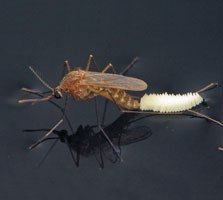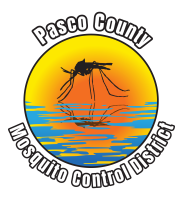Mosquito Biology
There are over 3,000 different species of mosquitoes throughout the world; over 200 species are recognized in the United States, 90 species of mosquitoes have been found in Florida, and more than 45 species have been identified in Pasco County. Many mosquito species have a different habitat, behavior, and preferred source of blood. Organized mosquito control is necessary because mosquitoes are not only a nuisance as biting insects, but are also involved periodically in transmitting diseases to humans and animals.
Mosquitoes Need Water
All mosquitoes have four stages of development – egg, larva, pupa, and adult. While some mosquitoes lay their eggs on the surface of the water, other species deposit their eggs on moist soil. These eggs can overwinter and may lie dormant for several months and even years not hatching until they are covered by rainwater or tides. In as little as four to five days after the eggs hatch, the larvae are full-grown. By this time, they have changed their shape, become less active, and enter their pupal stage. After one to two days, the pupal skin splits at the water’s surface, the adults emerge, and are soon ready to bite.
Only the Females Bite
When an adult mosquito emerges from the pupal stage they mate, and the female seeks a blood meal to obtain the protein necessary for the laying of her eggs. After a blood meal, it takes 3-5 days for blood to be digested and the eggs to develop. With one blood meal, a female may produce as many as 300 eggs.
While male mosquitoes do not take a blood meal both sexes feed on plant nectar. Male mosquitoes live for only a short time after mating, while the female can live for over two weeks, producing 2 or more egg batches. Females can spread diseases when a pathogen from an ingested blood meal replicates and she lives long enough to spread it to subsequent blood meal victims. Only a small percentage of mosquitoes live this long.


Females seek a place to lay their eggs, and the site chosen is based on cues from chemical receptors on their body. The female mosquito stores the sperm received through mating, and eggs are fertilized at the time they are laid. Mosquitoes have two general egg laying (oviposition) strategies which are usually specific for each genus. Mosquitoes will either lay eggs on existing water bodies, or they will lay eggs at sites that will later be flooded. In either case, the egg turns from white to black as its outer shell hardens before the egg is ready to hatch.
Once the eggs hatch, the larvae begin eating voraciously, and they grow rapidly, from about 1/16-inch to nearly 3/8-inch in size. Mosquito larvae eat microscopic plants (algae), animals (phytoplankton), and bacteria by filter feeding and grazing. Mosquitoes (and other invertebrates) do not have an internal skeleton like we do to support their organ systems. Instead, they have a hard external skeleton (exoskeleton) made of chitin. This hard exoskeleton hinders their rapid growth, and they shed it four times during the larval stage. Each one of the sub-stages in mosquito larval development is called an “instar”. This development process can take as little as 4-5 days in summer months, depending on the species and ambient temperature. However, some mosquitoes spend the winter in the water as 3rd instar larvae, and finish their aquatic phase in spring as water temperatures rise, emerging as adults in great hordes. The mosquito species that lay their eggs in areas that later are flooded with tides or rainwater also tend to have vast synchronous broods, whose peak population numbers are low during subsequent development times. In contrast, those species that lay their eggs on the water surface tend to have a more constant population (usually too many for our comfort) if the environmental conditions are stable.
The next stage is the pupa, or tumbler. This stage usually lasts about 2 days or less. During this time the mosquito transforms from the aquatic larva into the flying adult. The pupa does not feed. If you look carefully at a pupa through its semi-transparent exoskeleton, you will see the developing adult inside. After development, the adult emerges from the exoskeleton at the water surface, dries its wings, and takes flight to begin the cycle again.

The mosquito must breathe air to live. In both the larval and the pupal stage, the mosquito takes advantage of the surface tension of the water to stay attached to the surface layer so that they may gather air through special appendages called “siphons” for larvae and “trumpets” for pupae. Adults also use the water surface tension to stay suspended when they are emerging from pupal cases, drying their wings, and/or landing and laying their eggs.
